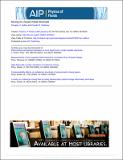Mixing in a liquid metal electrode
Author(s)
Kelley, Douglas H.; Sadoway, Donald Robert
DownloadKelley2014.pdf (1.093Mb)
PUBLISHER_POLICY
Publisher Policy
Article is made available in accordance with the publisher's policy and may be subject to US copyright law. Please refer to the publisher's site for terms of use.
Terms of use
Metadata
Show full item recordAbstract
Fluid mixing has first-order importance for many engineering problems in mass transport, including design and optimization of liquid-phase energy storage devices. Liquid metal batteries are currently being commercialized as a promising and economically viable technology for large-scale energy storage on worldwide electrical grids. But because these batteries are entirely liquid, fluid flow and instabilities may affect battery robustness and performance. Here we present estimates of flow magnitude and ultrasound measurements of the flow in a realistic liquid metal electrode. We find that flow does substantially affect mass transport by altering the electrode mixing time. Above a critical electrical current density, the convective flow organizes and gains speed, which promotes transport and would yield improved battery efficiency.
Date issued
2014-05Department
Massachusetts Institute of Technology. Department of Materials Science and EngineeringJournal
Physics of Fluids
Publisher
American Institute of Physics (AIP)
Citation
Kelley, Douglas H., and Donald R. Sadoway. “Mixing in a Liquid Metal Electrode.” Physics of Fluids 26, no. 5 (May 2014): 057102. © 2014 AIP Publishing LLC
Version: Final published version
ISSN
1070-6631
1089-7666